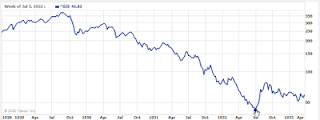John Kenneth Galbraith's "The Great Crash of 1929"
I just finished reading John Kenneth Galbraith’s “The Great Crash of 1929”. He wrote the book in 1955 and recounted what happened and looked at the reasons why. Very interesting, and while there are many things that are different, there are a number of similarities that I will try to highlight in my next couple of blogs.
From Sept. 3, 1929 until Nov. 13, the Times Industrial Index fell from 452 to 224 – almost 50% exactly. Prices stabilized for a while, but continued a long term trend down until they reached their eventual bottom at 58 on July 8, 1932. Meaning $1,000 invested on Sept. 3, 1929 became worth $130. Ouch.
So we all know that the Dow Industrials fell from a high of 14,164 on Oct. 9, 2007 to a low of 7,557 on Nov. 21, 2008 – a little less than 50%. Of course the Dow has rallied back to about 8,600 as I write this on Dec. 11, 2008 – an improvement of about 14% above the bottom. Looking back to 1929-30, the Dow Industrials rallied about 29% from a low in 1929 of 228 to close at 294 on April 14, 1930.
Of course the numbers do not really look at the reasons behind the crash. Galbraith summarizes the reasons:
1. The bad distribution of income.
2. The bad corporate structure. “The most important weakness was the vast new structure of holding companies and investment trusts.”
3. The bad banking structure.
4. The dubious state of the foreign balance.
5. The poor state of economic intelligence.
He morphs the 5th point into the government reaction to the economic events in the 1930’s. For example, I was surprised to learn that FDR’s Democratic Party ran their successful 1932 election bid with this as part of their platform called for an “immediate and drastic reduction of governmental expenditures” to accomplish at least a 25 % decrease in the cost of government.
Anyway, over the next week or two I will do some research on today’s metrics and contrast them to what Galbraith covers in his book about 1929. I think I will find quite a few similarities – especially on the first 4 points. However, it is really quite remarkable the difference in the government’s reaction this time. As Galbraith points out “The avoidance of depression and the prevention of unemployment have become for the politician the most critical of all questions of public policy.
From Sept. 3, 1929 until Nov. 13, the Times Industrial Index fell from 452 to 224 – almost 50% exactly. Prices stabilized for a while, but continued a long term trend down until they reached their eventual bottom at 58 on July 8, 1932. Meaning $1,000 invested on Sept. 3, 1929 became worth $130. Ouch.
So we all know that the Dow Industrials fell from a high of 14,164 on Oct. 9, 2007 to a low of 7,557 on Nov. 21, 2008 – a little less than 50%. Of course the Dow has rallied back to about 8,600 as I write this on Dec. 11, 2008 – an improvement of about 14% above the bottom. Looking back to 1929-30, the Dow Industrials rallied about 29% from a low in 1929 of 228 to close at 294 on April 14, 1930.

Of course the numbers do not really look at the reasons behind the crash. Galbraith summarizes the reasons:
1. The bad distribution of income.
2. The bad corporate structure. “The most important weakness was the vast new structure of holding companies and investment trusts.”
3. The bad banking structure.
4. The dubious state of the foreign balance.
5. The poor state of economic intelligence.
He morphs the 5th point into the government reaction to the economic events in the 1930’s. For example, I was surprised to learn that FDR’s Democratic Party ran their successful 1932 election bid with this as part of their platform called for an “immediate and drastic reduction of governmental expenditures” to accomplish at least a 25 % decrease in the cost of government.
Anyway, over the next week or two I will do some research on today’s metrics and contrast them to what Galbraith covers in his book about 1929. I think I will find quite a few similarities – especially on the first 4 points. However, it is really quite remarkable the difference in the government’s reaction this time. As Galbraith points out “The avoidance of depression and the prevention of unemployment have become for the politician the most critical of all questions of public policy.

Comments